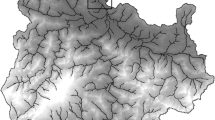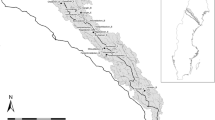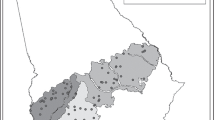Abstract
Objective assessment of habitat compensation is a central yet challenging issue for restoration ecologists. In 1997, a 3.4-km stream channel, designed to divert water around an open pit diamond mine, was excavated in the Barrenlands region of the Canadian Arctic to create productive stream habitat. We evaluated the initial success of this compensation program by comparing multiple biological attributes of the constructed stream during its first three years to those of natural reference streams in the area. The riparian zone of the constructed stream was largely devoid of vegetation throughout the period, in contrast to the densely vegetated zones of reference streams. The constructed stream also contained lower amounts of woody debris, coarse particulate organic matter (CPOM), and epilithon; had lower coverage by macrophytes and bryophytes; and processed leaf litter at a lower rate than reference streams. Species richness and densities of macroinvertebrates were consistently lower in the constructed stream compared to natural streams. This contributed to differences in macroinvertebrate assemblage structure throughout the period, although assemblages showed some convergence by year 3. The effectiveness of the constructed stream to emulate natural streams varied somewhat depending on the biological attribute being evaluated. Assessments based on individual attributes showed that minimal to moderate levels of similarity between the constructed stream and natural streams were achieved. A collective assessment of all biological and ecosystem attributes suggested that the constructed stream was not a good surrogate for natural streams during these first years. Additional time would be required before many characteristics of the constructed stream would resemble those of reference streams. Because initial efforts to improve fish habitat in the constructed stream focused on physical structures (e.g., weirs, vanes, rock, groins), ecological factors limiting fish growth were not considered and likely constrained success. We suggest that a greater focus on organic characteristics and vegetation within the stream and its riparian zone could have accelerated compensation. The addition of woody debris and CPOM, combined with planting of shrubs and herbs along the stream, should provide a source of allochthonous matter for the biotic community while large cobble and boulders should improve the physical stability of stream system, protecting its organic components.






Similar content being viewed by others
References
Benke AC, Wallace JB, Harrison JW, Koebel JW (2001) Food web quantification using secondary production analysis: predaceous invertebrates of the snag habitat in a subtropical river. Freshwater Biology 46:329–346
Bliss LC (1981) North American and Scandinavian tundras and polar deserts. In: Bliss LC, Heal OW, Moore JJ (eds) Tundra ecosystems: a comparative analysis. Cambridge University Press, pp 8–46
Choi YD (2007) Restoration ecology to the future: a call for new paradigm. Restoration Ecology 15:351–353
Department of Fisheries, Oceans (DFO) (1986) The Department of Fisheries and Oceans policy for the management of fish habitat. Communications Directorate. Fisheries and Oceans, Ottawa, Ontario
Environment Canada (1991) Canadian climate normals 1961–1990. Ottawa. http://www.msc-smc.ec.gc.ca/climate/climate_normals/index_e.cfm
Flory EA, Milner AM (1999) Influence of riparian vegetation on invertebrate assemblages in a recently formed stream in Glacier Bay National Park, Alaska. Journal of the North American Benthological Society 18:261–273
Harper DJ, Quigley JT (2005) No net loss of fish habitat: a review and analysis of habitat compensation in Canada. Environnemental Management 36:343–355
Hering D, Johnson RK, Kramm S, Schmutz S, Szoszkiewicz K, Verdonschot. PFM (2006) Assessment of European streams with diatoms, macrophytes, macroinvertebrates and fish: comparative metric-based analysis of organism response to stress. Freshwater Biology 51:1757–1785
Hunt RL (1988) A compendium of 45 trout stream habitat development evaluations in Wisconsin during 1953–1985. Wisconsin Department of Natural Resources Technical Bulletin 162. Wisconsin, 80 pp
Johnson BR, Cross WF, Wallace JB (2003) Long-term resource limitation reduces insect detritivore growth in a headwater stream. Journal of the North American Benthological Society 22:565–574
Jones NE, Tonn WM, Scrimgeour GJ (2003a) Selective foraging of age-0 Arctic grayling in lake outlet streams of the Northwest Territories, Canada. Environmental Biology of Fishes 67:169–178
Jones NE, Tonn WM, Scrimgeour GJ, Katopodis C (2003b) Productive capacity of an artificial stream in the Canadian Arctic: assessing the effectiveness of fish habitat compensation. Canadian Journal of Fisheries and Aquatic Sciences 60:849–863
Jones NE, Tonn WM, Scrimgeour GJ, Katopodis C (2003c) Ecological characteristics of streams in the Barrenlands near Lac de Gras, N.W.T., Canada. Arctic 56:249–261
Jones NE, Tonn WM (2004) Enhancing productive capacity in the Canadian Arctic: assessing the effectiveness of instream habitat structures in habitat compensation. Transactions of the American Fisheries Society 133:1356–1365
Karr JR (1999) Defining and measuring river health. Freshwater Biology 41:221–234
Laasonen P, Muotka T, Kivijaervi I (1998) Recovery of macroinvertebrate communities from stream habitat restoration. Aquatic Conservation and Marine Freshwater Ecosystems 8:101–113
Lamberti GA, Gregory SV, Ashkenas LA, Wildman RC, Moore KMS (1991) Stream ecosystem recovery following a catastrophic debris flow. Canadian Journal of Fisheries Aquatic Sciences 48:196–208
Malmqvist B, Rundle S, Brönmark C (1991) Invertebrate colonization of a new, man-made stream in southern Sweden. Freshwater Biology 26:307–324
Mackay RJ (1992) Colonization by lotic macroinvertebrates: a review of processes and patterns. Canadian Journal of Fisheries Aquatic Sciences 49:617–628
McCune B, Grace JB (2002) Analysis of ecological communities. MjM Software, Gleneden Beach
McCune B, Mefford MJ (1999) PC-ORD. Multivariate analysis of ecological data. Version 5.0. Version 5.0. MjM Software, Gleneden Beach
Merritt RW, Cummins KW (1996) An introduction to the aquatic insects of North America. Kendall/Hunt Publishing Company, Dubuque, Iowa
Milner AM, Knudsen E, Soiseth C, Robertson AL, Schell D, Phillips IT, Magnusson K (2000) Stream community development across a 200 year gradient in Glacier Bay National Park, Alaska, USA. Canadian Journal of Fisheries Aquatic Sciences 57:2319–2335
Minns CK, Kelso JRM, Randall RG (1996) Detecting the response of fish to habitat alterations in freshwater systems. Canadian Journal of Fisheries Aquatic Sciences 53(Suppl 1):403–414
O’Neill RV (1976) Ecosystem persistence and heterotrophic regulation. Ecology 57:1244–1253
Poff NL, Huryn AD (1997) Multi-scale determinants of secondary production in Atlantic salmon (Salmo salar) streams. Canadian Journal of Fisheries Aquatic Sciences 55:201–217
Reeves GH, Hall JD, Roelofs TD, Hickman TL, Baker CO (1991) Rehabilitating and modifying stream habitats. In: Meehan WR (ed) Influences of forest and rangeland management on salmonid fishes and their habitats. American Fisheries Society, Special Publication 19, Bethesda, Maryland, pp 519–557
Reynolds JF, Tenhunen JD (eds) (1996) Landscape Function and Disturbance in Arctic Tundra. Springer-Verlag, Ecological Studies Series Volume 120. Springer-Verlag, New York, 437 pp
Richardson JS, Mackay RJ (1991) Lake outlets and the distribution of filter feeders: an assessment of hypotheses. Oikos 62:370–380
Sawyer JA, Stewart PM, Mullen MM, Simon TP, Bennett HH (2004) Influence of habitat, water quality, and land use on macro-invertebrate and fish assemblages of a southeastern coastal plain watershed, USA. Aquatic Ecological Health Management 7:85–99
Scrimgeour GJ, Davidson RJ, Davidson JM (1988) Recovery of benthic macroinvertebrate and epilithic communities following a large flood in an unstable, braided New Zealand river. New Zealand Journal of Marine Freshwater Research 22:337–344
Shaw EA, Richardson JS (2001) Direct and indirect effects of sediment pulse duration on stream invertebrate assemblages and rainbow trout (Oncorhynchus mykiss) growth and survival. Canadian Journal of Fisheries Aquatic Sciences 58:2213–2221
Sokal RR, Rohlf FJ (1995) Biometry: the principles and practice of statistics in biological research, 3rd edn. W.H. Freeman and Company, New York
Sponseller RA, Benfield EF (2001) Influences of land use on leaf breakdown in southern Appalachian headwater streams: a multi-scale analysis. Journal of the North American Benthological Society 21:44–59
Wallace JB, Eggert SL, Meyer JL, Webster JR (1997) Effects of resource limitation on a detrital-based ecosystem. Ecological Monographs 69:409–442
Wang L, Robertson DM, Garrison PJ (2007) Linkages between nutrients and assemblages of macroinvertebrates and fish in wadeable streams: implication to nutrient criteria development. Environmental Management 39:194–212
Waters TF (1995) Sediment in streams: sources, biological effects, and control. American Fisheries Society. Monograph 7, Bethesda, Maryland, USA
Acknowledgments
This research was made possible through a grant and in-kind support from BHP Billiton Diamonds Inc (BHPB). Additional financial support was provided by the Canadian Circumpolar Institute (Northern Science Training Program and Circumpolar/Boreal Alberta Research grants), an NSERC industrial postgraduate scholarship (with support from BHPB) to NEJ, and a NSERC research grant to WMT, and funding from Limnos Aquatic Ecosystems Consulting to GJS. The Alberta Research Council kindly provided some field equipment. We also sincerely thank Michelle Bowman for discussions on assessment methods, anonymous reviewers of earlier drafts, and all members of the hard-working field crew, including Maria Sotiropoulos and Bev Gingras.
Author information
Authors and Affiliations
Corresponding author
Rights and permissions
About this article
Cite this article
Jones, N.E., Scrimgeour, G.J. & Tonn, W.M. Assessing the Effectiveness of a Constructed Arctic Stream Using Multiple Biological Attributes. Environmental Management 42, 1064–1076 (2008). https://doi.org/10.1007/s00267-008-9218-z
Received:
Revised:
Accepted:
Published:
Issue Date:
DOI: https://doi.org/10.1007/s00267-008-9218-z




